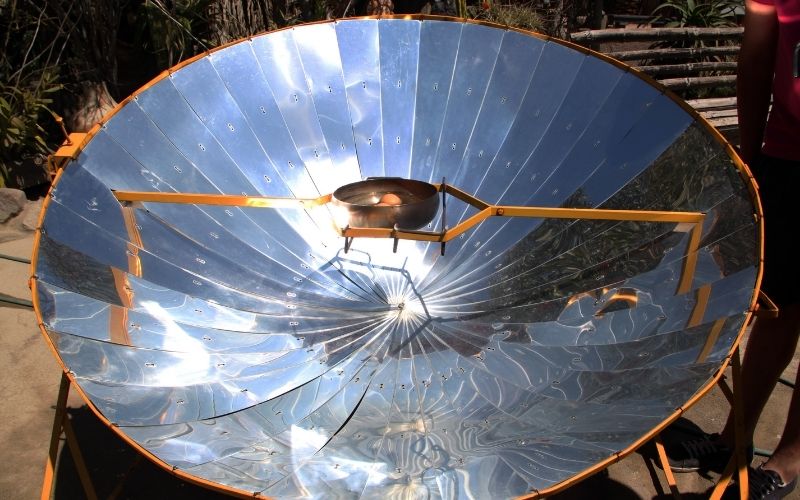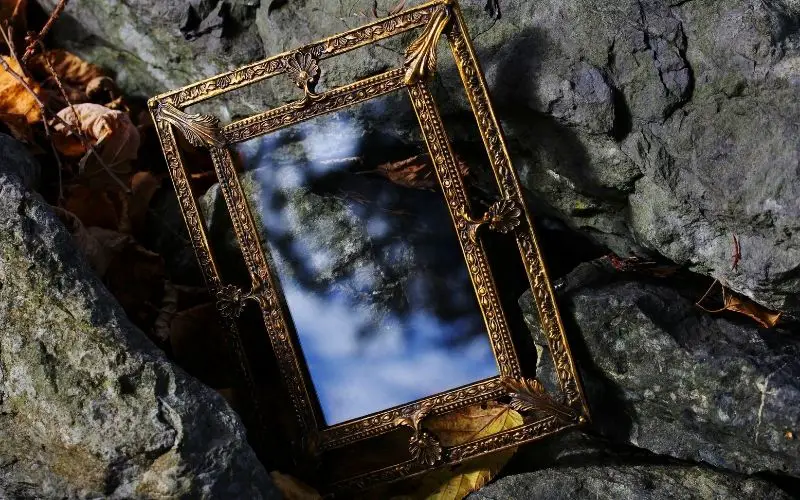Garden mirrors have often been used by gardeners to reflect sunlight into shaded areas of the garden to help plants to grow.
In recent years they have also become a feature of many gardens, as decorative items and also used to increase perceptions of space, as well as raising light levels.
With their increased use concerns have risen among some people as to whether garden mirrors can cause fires due to their reflective properties.
It is possible for a garden mirror, or other reflective item, to start a fire. Mirrors can concentrate sunlight and, if this light strikes a combustible surface in sufficient quantities then a fire could be caused.

Garden Mirrors and the Risk of Fires
Mirrors have often been used to start fires or concentrate sunlight to generate heat.
Common uses include solar ovens where a reflective mirrored surface is used to focus incoming sunlight to heat and cook food.
An incorrectly positioned garden mirror could result in the sun’s rays being focussed onto a surface or object that could combust, resulting in a fire.

What types of garden mirrors are most at risk?
There are generally three types of garden mirrors:
Flat mirrors – these are similar to the mirrors that you might find inside the home – a simple flat surface that is often hung on a wall, in some cases decorative.

A convex mirror – this is dish shaped with the center of the dish being more protruded than the edges – think of ball shaped, but just a portion of the ball.

Concave – these are also dish shaped mirrors but in these cases the center of the mirror sits lower than the edges – like a satellite dish.

All of these mirrors can present problems in terms of heat and potential fire generation but, by far the one that is most likely to be problematic is the concave shaped mirror.
Concave mirrors have the ability to focus light in a much more intense way than either flat or convex shaped mirrors and this makes them more dangerous.
A car headlamp uses concave shaped reflective materials to focus the beam of light onto the road and the same principle applies to a concave garden mirror.
Such a mirror can focus a concentrated beam of sunlight onto a spot in your garden – and it is this focused ‘ray’ that heats up and can result in fire.
What can you do to reduce the risk of fire from your garden mirror?
The best way to reduce the risk of fire from a garden mirror is not to use one.
If you do choose to use a mirror in your garden then there are some precautions that you can take:
– Make sure that the mirror is not positioned so that it reflects sunlight directly into a building as this could potentially start a fire inside the property.

After installing the mirror take time to check it at varying times of the day to see if the reflected rays are hitting anything that could be at risk of catching fire and re-position the mirror as needed.
– Keep combustible materials well away from where the mirror is positioned – this includes things like garden furniture, plants and even loose leaves or twigs.
- If you are using a concave shaped mirror then it is particularly important to take care as these mirrors can focus light in a very concentrated way.
- If you are going to be away from home for any length of time then it might be worth covering your mirror or taking it down to reduce the risk of fire while you are away.
- Use a flat or convex mirror instead of a concave one. These mirrors are less likely to focus sunlight and have much more ‘scatter effect’ type reflections.
- Place the mirror in a shaded area as opposed to in the sun. The temptation is to use a mirror to reflect light into shaded spots to brighten them and, whereas this may work it is often better ( and safer ) to place the mirror in the shade. This will help to highlight the area, brightening it without running the risk of fires.
What is a good material for garden mirrors?
There is a range of materials that can be used for garden mirrors and the most suitable will depend on the application.

For example, if you are looking to use the mirror to highlight an area of your garden at night then a material that is reflective but also glows in the dark may be more suitable.
A material that is shatterproof is also a good idea as this will reduce the risk of injuries if someone does happen to come into contact with the mirror.
Some good materials to consider for garden mirrors include:
– Mylar
– PETG
– Polycarbonate
– Glass ( tempered or safety glass is best )
Each of these materials has different benefits and it is worth doing some research to see which one will best suit your needs.
Mylar is a good choice for garden mirrors as it is lightweight, shatterproof and has a high reflectivity.
PETG is another good option as it is also lightweight and shatterproof but does not have the same level of reflectivity as Mylar.
Polycarbonate is a good all-round material for garden mirrors as it is shatterproof, has a high reflectivity and is also UV resistant.
Glass is a classic choice for garden mirrors but it is important to make sure that you use safety glass as this will reduce the risk of injuries if the mirror is broken.
Tempered glass is a good option as it is stronger than normal glass and is less likely to break.
There are a number of different materials that can be used for garden mirrors and the best choice will depend on your specific needs.
If you are looking for a material that is lightweight, shatterproof and has a high reflectivity then Mylar or PETG would be good choices.
If you are looking for a material that is shatterproof and has a high reflectivity but is also UV resistant then polycarbonate would be a good choice.
For a classic choice, glass is a good option but make sure to use safety glass to reduce the risk of injuries if it does break.
What shape and size is best for garden mirrors?
Garden mirrors come in a range of shapes and sizes and your needs and tastes will be the key factors in making your choices.
Some popular choices for garden mirrors include:
– Circular mirrors
– Rectangular mirrors
– Square mirrors
– Oval mirrors
There is no ‘right’ answer when it comes to the shape and size of garden mirrors and it is really a matter of personal preference.
Some people like to use smaller, more discreet mirrors while others prefer to use large mirrors to make a statement.
The size of your mirror will also be determined by the area you have to work with and the effect you are trying to create.
If you are looking to use the mirror to create the illusion of more space then a larger mirror is usually best.
On the other hand, if you are looking to use the mirror to highlight a specific area then a smaller mirror may be more suitable.

The shape of your mirror is also something to consider as this can have an impact on the overall look and feel of your garden.
For example, if you are looking for a more traditional look then a circular or oval mirror may be best while if you are going for a more modern look then a square or rectangular mirror would be a better choice.
There is no ‘right’ answer when it comes to the shape and size of garden mirrors and it is really a matter of personal preference.
The size of your mirror will be determined by the area you have to work with and the effect you are trying to create.
The shape of your mirror is also something to consider as this can have an impact on the overall look and feel of your garden.
How do I hang a garden mirror?
Garden mirrors can be hung in a number of ways depending on the weight and size of the mirror and the material it is made from.
The most common way to hang a garden mirror is by using screws and wall plugs.

This is a simple and effective method but it is worth checking that the wall you are hanging the mirror on is strong enough to support the weight of the mirror.
If you are unsure, it is always best to get a professional to help you with the installation.
Another option for hanging garden mirrors is to use a frame.
This is a good choice if you want to add extra protection to your mirror as it will help to prevent the glass from breaking if it is dropped or knocked.
It is also worth considering using a frame if you are hanging a large mirror as it will help to distribute the weight more evenly.
When choosing a frame, make sure that it is made from a durable material such as metal or hardwood as this will help to extend the life of your mirror.
Finally, you could also choose to hang your garden mirror without using any screws or nails.
This can be done by using adhesive hooks which are designed to hold a variety of different objects.
Adhesive hooks are easy to use and can be removed without damaging your wall or mirror.
Before choosing this option, it is important to check the weight limit of the adhesive hooks to make sure that they will be able to support the weight of your mirror.
Garden mirrors can also be placed in trees, bushes or on posts and your choice will really be determined by your personal tastes and the type of mirror that you choose.
How do I care for my garden mirror?
Caring for your garden mirror is relatively simple and will largely depend on the material it is made from.
If your mirror is made from glass, it is important to clean it regularly to prevent dirt and grime from building up.





You can use a standard window cleaner or a mild soap and water solution to clean your mirror.
It is also important to wipe away any condensation that may build up on the mirror as this can lead to water spots.
If your mirror is made from a metal or plastic, it is important to clean it regularly to prevent it from tarnishing or discolouring.
You can use a mild soap and water solution or a specialist metal or plastic cleaner to clean your mirror.
It is also important to wipe away any condensation that may build up on the mirror as this can lead to water spots.
If you have a garden mirror with a frame, it is important to clean both the mirror and the frame regularly.
You can use a mild soap and water solution or a specialist cleaner to clean both the mirror and the frame.
It is also important to wipe away any condensation that may build up on the mirror as this can lead to water spots.

Final words
Garden mirrors are a great way to add light and space to your garden.
They can be used to create a number of different looks and effects and are relatively easy to care for.
When choosing a garden mirror, it is important to consider the size, shape and material of the mirror as well as the method you will use to hang it.
When using a garden mirror always remember to position it carefully, taking into consideration the focus of the reflected light and the area onto which this falls.
With careful positioning and the right choice, you will be able to enjoy the effects of a garden mirror without the risks of fire or other problems.






